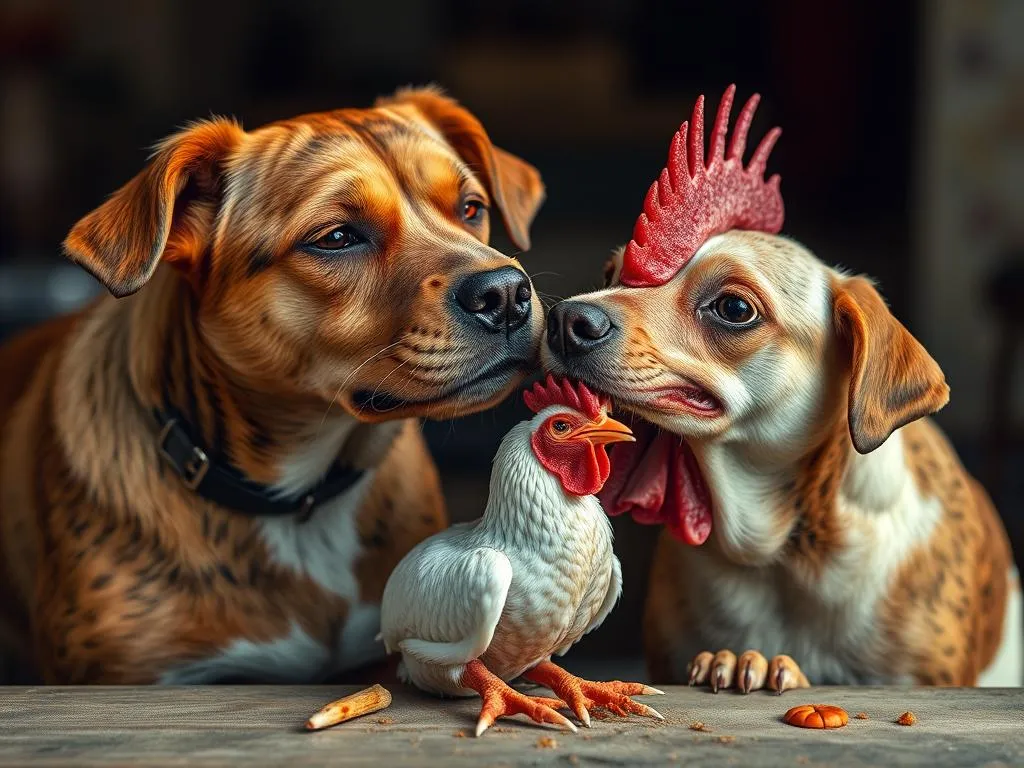
Introduction
Understanding dog nutrition is crucial for any pet owner looking to ensure their furry friend lives a healthy and happy life. One important aspect of this is knowing what foods are safe and beneficial for dogs. With so many options available, it can be overwhelming to determine what to include in their diet. One often overlooked food is chicken gizzards. So, can dogs eat chicken gizzards? This post will delve into their nutritional value, benefits, risks, and how to safely incorporate them into your dog’s diet.
Understanding Dog Nutrition
A dog’s diet must be balanced and include essential nutrients to support overall health. The following nutrients are vital for maintaining your dog’s well-being:
- Proteins: Essential for building and repairing tissues, proteins are the building blocks of your dog’s body. They play a significant role in muscle development and overall growth.
- Fats: Healthy fats provide energy and support cell growth. They also help in the absorption of certain vitamins and contribute to a shiny coat.
- Carbohydrates: While dogs primarily thrive on protein and fats, carbohydrates provide an additional energy source. They also aid in digestion and overall gut health.
- Vitamins and minerals: These micronutrients are crucial for various bodily functions, including immune system support and bone health.
A balanced diet not only helps dogs maintain a healthy weight but also prevents various health issues. Despite common beliefs, dogs do not thrive on a strictly carnivorous diet; a variety of foods is essential for optimal health.
The Nutritional Value of Chicken Gizzards
What exactly are chicken gizzards? They are muscular organs found in the digestive tract of chickens, and they serve a crucial role in breaking down food. Chicken gizzards are an excellent source of nutrition for dogs, providing several key benefits.
Nutritional Profile of Chicken Gizzards
- Protein content: Chicken gizzards are incredibly rich in protein, making them an excellent addition to your dog’s diet. A 100g serving contains about 26g of protein, which supports muscle development and overall growth.
- Fat content: They contain a moderate amount of fat, approximately 5g per 100g serving. This balance of protein and fat can help maintain energy levels without leading to obesity.
- Vitamins and minerals: Chicken gizzards are packed with essential vitamins and minerals, including:
- B vitamins: Important for energy metabolism and brain health.
- Phosphorus: Crucial for bone health and energy production.
When compared to other common dog food sources, chicken gizzards stand out for their high protein and nutrient density, making them a valuable addition to a dog’s diet.
Can Dogs Eat Chicken Gizzards?
Yes, dogs can safely eat chicken gizzards, but there are important factors to consider when offering them as part of your dog’s diet.
Safety of Chicken Gizzards for Dogs
- Raw vs. cooked gizzards: Some pet owners choose to feed their dogs raw chicken gizzards, while others prefer cooked options. Cooking gizzards can eliminate the risk of bacterial contamination but may also reduce some nutrients. If opting for raw, ensure they are sourced from a reputable supplier, and always consult with a veterinarian.
- Risks of feeding gizzards: When feeding chicken gizzards, be aware of potential risks, including:
- Bacterial contamination: Raw poultry can harbor bacteria such as Salmonella or Campylobacter. Always handle raw gizzards with care and practice good hygiene.
- Choking hazards: Ensure gizzards are appropriately sized for your dog to prevent choking. Larger dogs can handle whole gizzards, while smaller breeds may require them to be cut into smaller pieces.
Recommended Serving Sizes
The serving size of chicken gizzards should vary depending on your dog’s size and dietary needs. Generally, a few ounces a few times a week is sufficient for most dogs. Always monitor your dog’s reaction and adjust serving sizes accordingly.
Frequency of Inclusion in Dog Diets
Chicken gizzards should be considered a complementary food rather than a staple. Including them in your dog’s diet a couple of times a week can provide nutritional benefits without overwhelming their digestive system.
Benefits of Feeding Chicken Gizzards to Dogs
Incorporating chicken gizzards into your dog’s diet can yield several benefits:
- High protein source: Given their substantial protein content, chicken gizzards support muscle development and overall growth, especially in active or young dogs.
- Supporting muscle development: The amino acids found in proteins are vital for muscle repair and growth, making gizzards an excellent addition to a post-exercise meal.
- Potential benefits for skin and coat health: The healthy fats present in chicken gizzards can contribute to a shiny coat and healthy skin.
- Enhancing overall energy levels: The combination of protein and fats provides sustained energy, helping your dog stay active and playful throughout the day.
Potential Risks and Considerations
While chicken gizzards can be beneficial, there are also some risks and considerations to keep in mind:
- Allergies and food sensitivities: Some dogs may be allergic or sensitive to poultry. If introducing gizzards for the first time, monitor your dog for any signs of allergies, such as itching or gastrointestinal upset.
- Overfeeding and weight management: Treat chicken gizzards as a supplement to your dog’s regular diet. Overfeeding can lead to weight gain and related health issues.
- Gastrointestinal upset: Introducing any new food can cause digestive upset. If your dog experiences diarrhea or vomiting after eating gizzards, consult your veterinarian.
- Importance of consulting a veterinarian: Before making significant changes to your dog’s diet, it’s always best to consult with your veterinarian. They can provide personalized advice based on your dog’s specific health needs.
How to Prepare Chicken Gizzards for Dogs
If you decide to include chicken gizzards in your dog’s diet, proper preparation is essential.
Safe Preparation Methods
- Cooking methods: The safest way to prepare chicken gizzards is by boiling or baking them. Avoid frying or using oil, as added fats can be unhealthy for dogs.
- Seasoning and additives to avoid: Do not add salt, spices, or other seasonings when preparing gizzards for your dog. These can be harmful to their health.
Tips for Incorporating Gizzards into Meals
You can serve chicken gizzards on their own as a treat or mix them into your dog’s regular meals. Here are a few suggestions:
- Chop cooked gizzards into small pieces and mix them into kibble or wet food.
- Create homemade dog food recipes that include gizzards as a primary protein source.
Alternative Organ Meats for Dogs
While chicken gizzards are a great option, there are other organ meats that can also benefit your dog’s diet:
- Liver: Rich in vitamins A, B, and iron, liver is a nutrient-dense organ meat that can enhance your dog’s diet. However, it should be fed in moderation due to its high vitamin A content.
- Hearts: Chicken hearts are also high in protein and packed with nutrients, making them a great alternative to gizzards.
- Kidneys: Beef or lamb kidneys provide additional nutrients and can be included in your dog’s diet.
Nutritional Comparisons with Chicken Gizzards
Each type of organ meat offers unique nutritional benefits. For example, while chicken gizzards are an excellent protein source, liver provides more vitamins, and hearts are known for their high taurine levels, which are beneficial for heart health. Mixing different organ meats can create a well-rounded diet for your dog.
Expert Opinions and Research
Veterinarians and pet nutritionists often emphasize the importance of variety in a dog’s diet. Research has shown that organ meats, like chicken gizzards, play a significant role in providing essential nutrients. Many experts agree that including a variety of protein sources, including organ meats, can promote overall health and wellness in dogs.
Conclusion
In summary, chicken gizzards can be a nutritious addition to your dog’s diet, offering numerous health benefits, including high protein content and essential vitamins. However, moderation is key, and it’s essential to consider the potential risks and consult with a veterinarian before introducing new foods. A balanced diet that includes variety is crucial for maintaining your dog’s health and well-being.
FAQs
-
Can puppies eat chicken gizzards?
Yes, but introduce them gradually, as puppies have sensitive digestive systems. Consult your veterinarian for recommendations. -
How often can I feed my dog gizzards?
A few ounces a couple of times a week is typically a good guideline. Adjust based on your dog’s size and dietary needs. -
Are chicken gizzards better than kibble?
Chicken gizzards provide additional nutrients that kibble may lack. However, they should complement a balanced diet rather than replace kibble entirely. -
What should I do if my dog has an allergic reaction?
If you suspect your dog is having an allergic reaction, discontinue feeding gizzards and consult your veterinarian immediately.
By understanding the nutritional benefits and risks associated with chicken gizzards, you can make informed decisions to enhance your dog’s diet and overall health.









